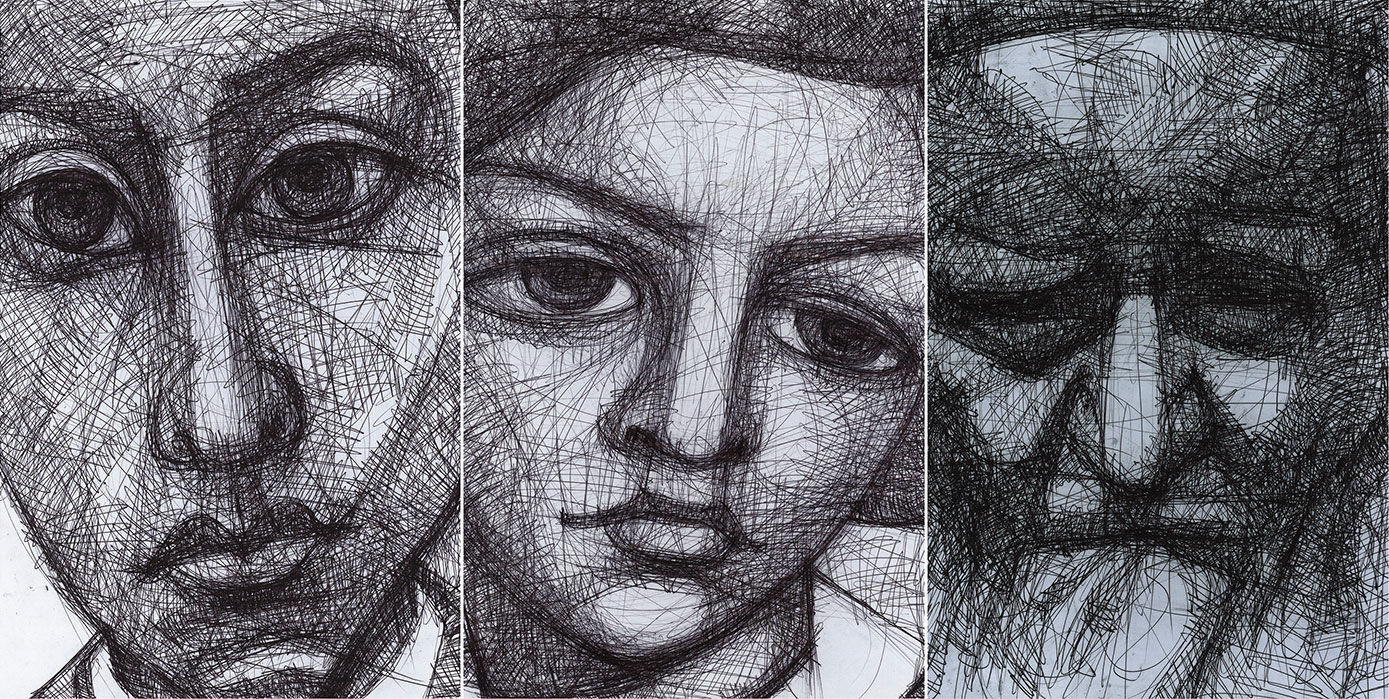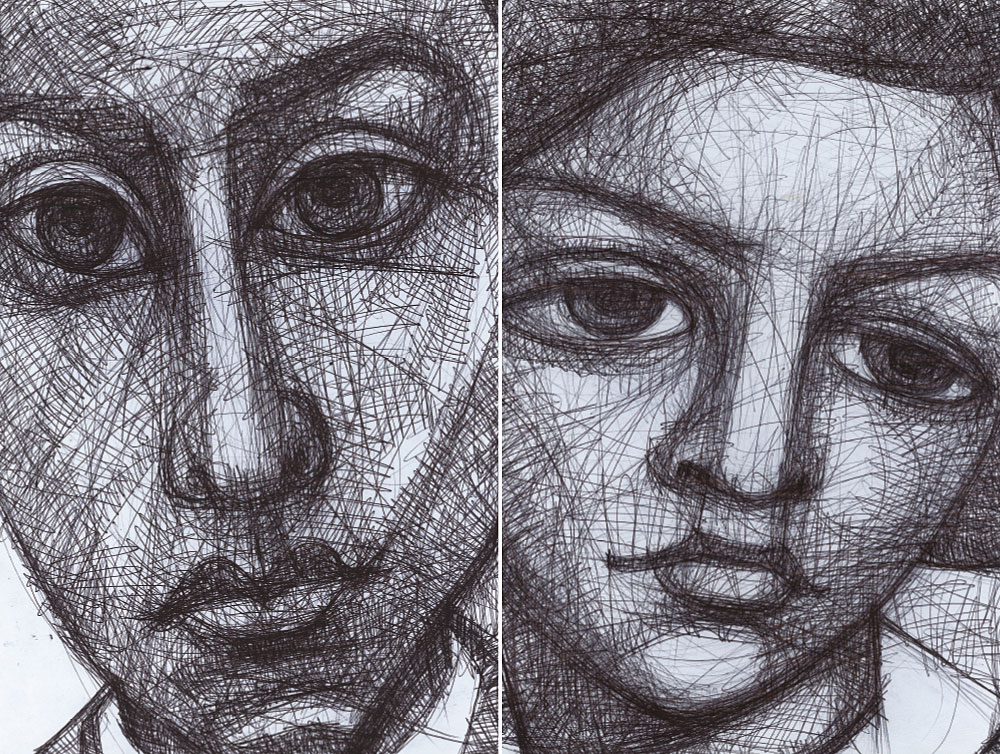




'If anything can, it is memory that will save humanity' Elie Wiesel
For more than four years now, I have been working on a large-scale project «They are Looking at Us». Since the year 2017, I completed over 4500 of Portraits (drawings, ballpoint on paper, 42 x 30 cm). Each portrait of the project «They are Looking at Us» is based on archival photographs of victims of the Holocaust and of Nazi persecution. For me, is important to repeat these faces with my own hand, to “feel” them, and thus make them alive again. The quantity of works is also important to point to the scale of the tragedy. The portrayed are shown «enface" or in profile. Sometimes faces are fragmented, which enhances the sense of closeness to us. Some of those depicted are known by name. Others are anonymous and their fate is still unknown. I draw people of all ages and of all social backgrounds, but I pay special attention to children.
I try to use the photographic document as an impulse for my imagination to meet a living person and embrace him or her with all the facets of life and loving affection. I look at those persons spellbound and they look back at me. The eyes are the center of the portraits. I pursue their charisma in their facial features. I see the people full of life and love: a mother with her daughter and son, a large family, a groom with a bride. A mother looks proudly at her beautiful daughter, an adult son patronizingly hugs his mother, twins. Sometimes a smile on the face, a face is illuminated by the sun … Happy moments in these peoples’ lives were captured on the photos before mass persecution began, which ended in extermination. And in these photographs from concentration camps, you see and feel what is impossible, not only to express in words, but even to understand. Consciousness can not overcome this impossibility to understand: how could such a thing have happened? And carried out by humans … There were screams. There was despair. There were the silent groans of mothers. And, after that, only a terrible silence. And nothing else … He is looking at me. She is looking at me. They are looking at me. They are looking at us.
The line is a continuation of my hand and my feeling and my despair and my tears and my inability to understand. The line reflects my feelings. Sometimes the line beats like ecstatic strokes; sometimes the line creates tonal densities that are very different depending on sensations. Sometimes, the line cuts along the empty spaces left as free spaces. Sometimes, the line beats in rhythms that represent the face as an open field of life with a wide range of emotions. And often the face has been built up using soft, circular movements of line, with a hard accent on the eyes to achieve maximum dynamic in contact with the viewer.
My aim, through artistic means, is to reflect the inner world of a person and the spectrum of that person’s feelings. When I work on a portrait, a person and his or her life is in front of me. While working on the portraits, I feel the despair that gripped these people and the pain from the fact that we lost them. I am tormented by a question for which there is no answer: how this could be possible? I hope that the strong feeling which I have during the process of working will be experienced by the viewer in front of these portraits. If the viewer senses this, thoughts will come through feelings.
Human beings - this is most important. Indifference is the greatest evil of all. Man is not a machine, man is not a beast - man is born to love. Man is born free, but becomes a slave to hatred.
The eyes are the focus of every image. Their expression is at the heart of the project concept. This is not about accusation or condemnation, but about the emotional connections that are formed in visual dialogue with the viewer. The humanity of these people in all its complexity, contradictions and vulnerability lives in these portraits and deeply affects those who see them.
Each person is unique and has intrinsic value. Each person is unique in their potential possibilities. The eyes of these people are talking. The important aim of the project is that the eyes of the portrayed victims of Holocaust will meet the eyes of future generations and communicate with them. Through the eyes of those portrayed, spectators should feel the whole spectrum of emotions from these people and pain from the fact that we have lost them.
The sheer quantity of faces that I draw imbues the project with an intense atmosphere that has a long term impact on the viewer. The result is an unsettling, emotional installation that pays tribute to people whose lives were cut short, reminding the living of each of their existences.
I believe that now is the time it is absolutely imperative to remember those we have lost and to feel the grief of that loss. Today, people want to forget the past. They want a comfortable, carefree existence. Indifference triumphs, and that is what is most terrible. Together with Holocaust survivor and author, Elie Wiesel, I am convinced that help for the future will come from memories alone. Indifference makes exclusion and abuse possible. Inhumanity, hate and a lack of compassion arise from ignorance and apathy. Modern society often promotes false values and offers harshness and brutality as a means of achieving success. This, however, turned out to be the path to destruction and violence. And the most important thing is just the opposite – humanity, love and warmth between people.
At the moment, a resurgence of nationalism, anti-Semitism, and xenophobia can be felt everywhere. Fear, violence and indifference towards the plight of others, are becoming increasingly common. Therefore the project «They are Looking at Us» is not only an appeal and a reminder. Rather, it wants directly to encourage and to strengthen a feeling of the ability to act of every human being as well as the respect for the dignity of every human being.
Project wants to make contact, it wants to generate empathy, it wants to generate feelings - so that we all recognize ourselves in the eyes, in the faces that look at us. People with longings and fears, with dislikes and sympathies, people full of love.
«It happened, therefore it can happen again: this is a core of what we have to say». This is what Holocaust survivor and author Primo Levi wrote. Holocaust memory should thus be a warning that nationalism, anti-Semitism and xenophobia can have a significant consequences.
Project want to talk to people about the Holocaust through feelings. When the eyes of the viewer meet the eyes of these people, words are no longer needed. Thoughts will come through feelings. The project «They are Looking at Us» is built on feeling and I hope that the feelings I experience when these portraits are born, will be experienced by the people who see them.
Olga Stozhar